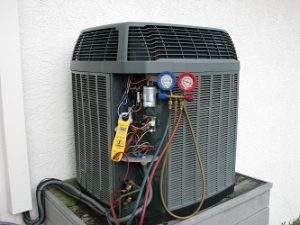Not all molds are the same. For instance, your brie cheese or camembert relies on mold for its unique texture and flavor. Sadly, the kinds of mold you may find prowling in your air conditioner (AC) aren’t especially benevolent or helpful ones. In truth, they’re much more potentially harmful than advantageous.
 Mold spores are the mechanism through which mold breeds. While your air conditioning unit is inactive, it’s the perfect petri dish for a stubborn mold spore to multiply. More spores will be blown out and become airborne. They’ll scatter all over your home, landing on you, your clothes, and your food. If you have an allergic reaction to mold, its presence in your AC is likely to cause a serious effect.
Mold spores are the mechanism through which mold breeds. While your air conditioning unit is inactive, it’s the perfect petri dish for a stubborn mold spore to multiply. More spores will be blown out and become airborne. They’ll scatter all over your home, landing on you, your clothes, and your food. If you have an allergic reaction to mold, its presence in your AC is likely to cause a serious effect.
Other reasons why a moldy AC is a dreadful
When left long enough, mold can also lead to major problems that can affect your AC’s efficiency. In some cases, an accumulation of mold can even cause blockages within the AC drains. The outcome can be an inconvenient and expensive breakdown when you need your cooling system the most.
Indications of mold in your AC
Odds are you won’t see any obvious indications of mold to begin with. The main sign you may have of mildew covered air conditioner is an offbeat smell when it’s in operation. If you’ve excluded all other potential sources of the smell and yet it’s still there, then you need to consider cleaning your AC.
Once a mold colony is established, you might notice gray circular or tell-tale black marks on the interior surfaces of your air conditioner.
Steps to take to confirm the presence of mold in your AC
Check your air conditioning ducts and the interior of the unit itself for visible signs of mold. Mold can also be found on the AC drain, the coil, and on the fan itself.
Tips and tricks for dealing with a moldy air conditioner
If you’re going to deal with the problem of a moldy AC on your own, you need to take necessary safety measures to make sure that you protect yourself by wearing protective gears. You should always wear a face shield or filter mask and gloves rated to shield you from mold spores. Your first step is to pull the unit apart in accordance with your owner’s manual. You will then need to vacuum the inside of the entire unit and remove and wash the filters under running water.
Use warm, soapy water to wipe down all surfaces of the AC before letting them dry completely. Then clean them again, this time with a commercial air conditioner cleaner and apply a mold-inhibitor using a clean, damp cloth. A number of good mold inhibitors are in fact naturally-derived products including:
- Vinegar and water
- Tea tree oil
- Oil of cloves
- Water and methylated spirits
There’s a controversy on whether bleach can effectively kill molds as there are some who believe that it simply bleaches the mold, making it invisible to the naked eye, as opposed to totally getting rid of it.
